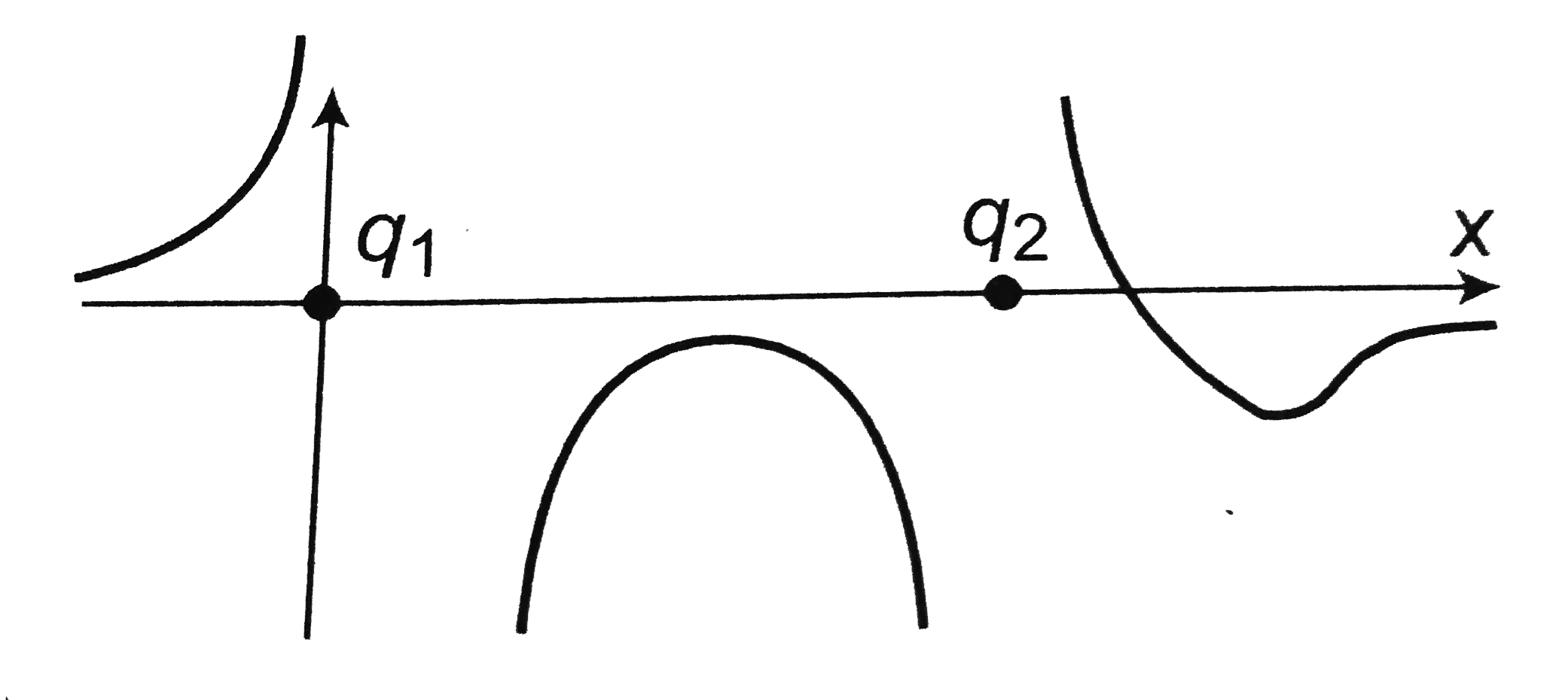Exercises from CENGAGE PHYSICS (ENGLISH) Chapter 11:COULOMB LAW AND ELECTRIC FIELD for Class 12
| Class 12 | PHYSICS |
| Chapter | COULOMB LAW AND ELECTRIC FIELD |
| CENGAGE PHYSICS (ENGLISH) | Exercises |
| Medium | English |
| Academic Year | 2023-2024 |
Question 3
(a) Can two bodies having like charge attract each other (yes/No)
(b) Can a charged body attract an unchanged body? (yes/No)
(c ) Two identical metallic spheres of exactly equal masses are taken, one is given a positive charge q and the other an equal negative charge. Their masses after charging are different. Co,,ent on the statement. View SolutionQuestion 12
Two identical conduction spheres, one having an initial charge +Q and the other initially uncharged, are brought into contact.
(a) What is the new charge on each sphere?
(b) While the spheres are in contact, a positively chaged rod is moved close to one sphere, causing a redistribution of hte charges on the two spheres so the charge on hte sphere closest to the rod has a charge-Q. What is the charge to the other sphere?View SolutionQuestion 13
Two identical conducting spheres are charged by induction and then separated by a large distance, sphere 1 has charge +Q and sphere 2 has charge -Q. A third sphere is initially uncharged. If sphere 3 is touched to sphere 1 and separated and then touched to sphere 2 and separated what is the final charge on each of the three spheres?View SolutionQuestion 19
Figure shows three arrangements of an electrons e and two protons p(where Dgtd)
(a) Rank the arrangement according to the magnitude of the net electrostatic force on the electron due to the protons placing the largest first.

(b) In situation (c), is the angle between the net force on the electrons and the line labeled horiontal less than or more than 45∘?View SolutionQuestion 20
Figure shows two charge particles on an axis. The charges are free to move. At one point, however, a third charged particle can be placed such that all three particles are in equilibrium.
(a) Is that point to the left of the first two particles to their rightm or between them?
(b) should the third paricle be positively or negatively charged?
(c ) Is the equilibrium stable or unstable?
 View Solution
View SolutionQuestion 22
Figure shows four situations in which particles of charge +q or -q are fixed in place. In each the particles on the x-axis are equidistant from the y-axis. The particle on the y-axis experiences an electrostatic force F from each of these two particle.
(a) Are the magnitudes F of those force the same or different?
(b ) Is the magnitude of the net force on the particle on the y-axis. equal to grater than, or less than 2F?
(c ) Do the x-components of the two forces add or cancel?
(d) Do the y-components of the force add or cancel?
(e ) Is the direction of the net forcce on the middle particle that of the canceling components or the adding components?
(f) What is the direction of the net force on the middle particle ?
 ,
, 
 ,
,  View Solution
View SolutionQuestion 24
Two small balls having equal positive charge Q (coulumb) on each suspended by two insulating strings of equal length L (metre) from a hook fixed to a stand. The whole set-up is taken in a satellite into space where there is no gravity (state of weightlessness). Then tension (newtons) in each string is:View SolutionQuestion 25
Suppose we have a large number of identical particles, very small in size. Any two of them at 10cm separation repel with a force of 3×10−10N.
(a) If one of them is at 10 cm from a group (of very small size) of n others, how strongly do you expect it to be repelled?
(b) Suppose you measure the repulsion and find it 6×10−6N. How many particles were there in the group? View SolutionQuestion 28
Two insulated identically sized charged copper spheres A and B have their centers separated by a distance of 50 cm. A third sphere of the same size but uncharged is brought in contact with the first, then in contact with the second and finally removed from both. What is the new force of repulsion between A and B? View SolutionQuestion 29
Two small balls having equal positive charge Q (coulumb) on each suspended by two insulating strings of equal length L (metre) from a hook fixed to a stand. The whole set-up is taken in a satellite into space where there is no gravity (state of weightlessness). Then tension (newtons) in each string is:View SolutionQuestion 33
A particle with positive charge Q is held fixed at the origen. A second particle with positive charge q is fired at the first paricle, which follows the trajectory as shown in fig.

(a) Is the angular momentum of the second particular momentum of the second particle constant about some axis? Why or why not? Give reason to support your answer.
(b) Does the Coulomb force that one charge exerts on other charges changes if the other charges are brought nearby?(yes/No)View SolutionQuestion 34
Fig. shows some of the electric field lines due to three point charges arranged along the vertical axis. All three charges have the same magnitude.
(a) What are the signs of each of the three charges? Explain your reasoning.
(b) At what points(s) is the magnitude of the electric field the smallest? Explain your reasoning. Explain how the fields produced by each individual point charge combine to give a small net field at this point or points.
(c ) Two point charges q and -q are placed at a distance d apart. What are the points at which the resultant electric field is parallel to the line joining the two charge?
 .View Solution
.View SolutionQuestion 38
In fig, two particles, each of charge -q are arranged symmetrically about the y-axis, each producing an electric field at point P on the y-axis.
 .
.
(a) Are the magnitudes of the fields at P equal?
(b) Is each electric field directed towards or away form the charge producing it ?
(c ) Is the magnitude of the net electric field at P equal to the sum of the magnitudes E of the two field vectors (is it equal to 2E)?
(d) Do the x-components of those two field vectors add or cancel?
(e ) Do their y-components add or cancel?
(f) Is the diretion of the net field at P that of the canceling components or the adding components?
(g) What is the direction of the net field? View SolutionQuestion 39
In fig. a plastic rod in the form of circular are with charge +Q unformly distributed on it produces an electric fieldof magnitude E at the centre of curvature (at the origin). In fig., more circular rods with identical umform charges +Q are addes until the circle is complete. A fifth arrangement (which would be labeled e) is like taht in d except that the roed in the fourth quadrant has charge-Q. Rank all the five arrangements according to the magnitudes of the electric field at the center of curvature, greatest first.
 View Solution
View SolutionQuestion 42
Three small spheres x,y, and z carry charges of equal magnitudes and with signs shown in fig. They are palced at the vertices of an isosceles triangle with the distance betwwen x and y equal to the distance between x and z. sphere y and z are held in place, but sphere x is free to move on a frictionless surface.

(a) what is the direction of the electric force on sphere x at the point shown in the figure?
(b) Which path is sphere x likely to take when released? View SolutionQuestion 43
Two identical positive charges are fixed on the y-axis, at equal distances from the origin O. A particle with a negative charges starts on the x-axis at a large distance from O. moves along the x-axis passes through O, and moves far away from O on the other side. Its acceleration a is taken as positive along its direction of motion. Plot acceleration a of the particle against its x-coordinate. View SolutionQuestion 44
An electric field is defined in terms of q0 a small positive charge. If the definition was in terms of a small negative charge of the same magnitude, then compared to the original field the newly defined electric field.
(a) would point in the same direction and have the same magnitude.
(b) would point in the opposite direction and have the same magnitude.
(c ) would point in the same direction and have the different magnitude.
(d) would point in the opposite direction and have the different magnitude. View SolutionQuestion 47
An electron (mass me)falls through a distance d in a uniform electric field of magnitude E.
 ,
,
The direction of the field is reversed keeping its magnitudes unchanged, and a proton(mass mp) falls through the same distance. If the times taken by the electrons and the protons to fall the distance d is telectron and tproton respectively, then the ratio telectron/tproton.View SolutionQuestion 48
Two charged metal plates in vacuum are 10cm apart. A uniform electric field of intensity (45/16)×103NC−1 is applied between the plates. An electron is released between the plates from rest at a point just outside the negative plate.
(a) Calculate how long (t) will the electron take to reach the other plate?
(b) At what velocity (v) will it be electron take to hits teh other plate? View SolutionQuestion 49
Two idential point charges Q are kept at a distance r from each other. A third point charge is placed on the line joing the above two charges such that all the three charges are in equilibrium. The third charge
(a) should be of magnitude q=………..
(b) should be of sign .......
(c ) should be placed ........ . View SolutionQuestion 55
Two point-like charge a and b whose strengths are equal in absolute value are positioned at a certain distance from each other. Assumeing the field strenght is positive in he direction of the r axis. Determine the sign of the charge for each distribution of the field strenght between charge for each distribution of the field strenght between charges src="https://d10lpgp6xz60nq.cloudfront.net/physics_images/BMS_V03_C01_E01_055_Q01.png" width="80%">View SolutionQuestion 56
An electron moving in a gravitational free space enters a unifrom electric field E with an initial velocity shown in fig.
 .
.
(a) Find the deflection distance h in the field .
(b) Find an expression for the velocity of electron when it just emerage from the field.
(c ) Find an expression for the total deflection distance H at a vertical screen placed at a distance l from the region of uniform field .(Assume that the field abruptly ends outside the field. ). View SolutionQuestion 57
Protons are projected with an initial speed vi=6kms−1 from a fileds-free region →E=−900ˆjNC−1 present above the plane as shown in fig. The initial velocity vector of the protons makes an angle u with the plane. The proton are to hit a target that lies at a horizontal cross the plane and enter the electric field. Find the angle θ at which the protons must pass through the plane to strike the target.
 View Solution
View SolutionQuestion 58
Two indentical point charges having magnitude q each are placed as shown if fig. If we place a negative cahrge (of magnitude -q and mass m)at the midpoint of charges and displaced along the x-axis, examine whether it will perform simpe harmonic motion. If yes then find the time period of oscillation of the particle.
 View Solution
View SolutionQuestion 60
A charged particle of radius 5×10−7m is located in a horizontal electric field of intensity 6.28×105Vm−1. The surrounding medium has the coeffecient of viscosity η=1.6×10−5Nsm−2. The particle starts moving under the effect of electric field and finally attains a uniform horizontal speed of 0.02ms−1. Find the number of electrons on it. Assume gravity free space. View SolutionQuestion 61
Suppose that 1.0g fo hydrogen is separated into electrons and protons. Suppose also that the protons are palced at the earth's north pole and the electrons are placed at the south pole. What is the resulting compression force on earth? (Given that the radius of rarth is 6400 km).View SolutionQuestion 62
Two identical conducting small spheres are placed with their centers 0.3 m aparts. One is given a charge of 12.0 nC and the other a charge of −18.0nC.
(a) Find the electric force exerted by one sphere on the other?
(b) If the spheres are connected by a conducting wire, find the electric force between the two after they attain equilibrium. View SolutionQuestion 66
Two identical particles are charged and held at a distance of 1m form each pther. They are found to be attraction each other with a force of 0.027N . Now they are connected by a conducting wire so that charge folws between them. Whe the charge flow stop, they are found to be repelling each other with a force of 0.009N. Find the initial charge on each particle. View SolutionQuestion 68
Three point charges of +2μC,−3μC , and −3μC are kept at the vertices A, B, and C, respectively of an equilatreral triangle of side 20 cm. what should be the sign and magnitude of the charge (q) to be placed at the midpoint (M) of side BC so that the charge at A remains in equilibrium?
 View Solution
View SolutionQuestion 69
Two small beads having positive charges 3q and q are fixed at the opposite ends of a horizontal, insulating rod, extending from the origin to the point x=d as shown in fig. A third small charged bead is free to slide on the rod. At what position is the third bead in equilibrium? Can it be in stable equilibrium ?
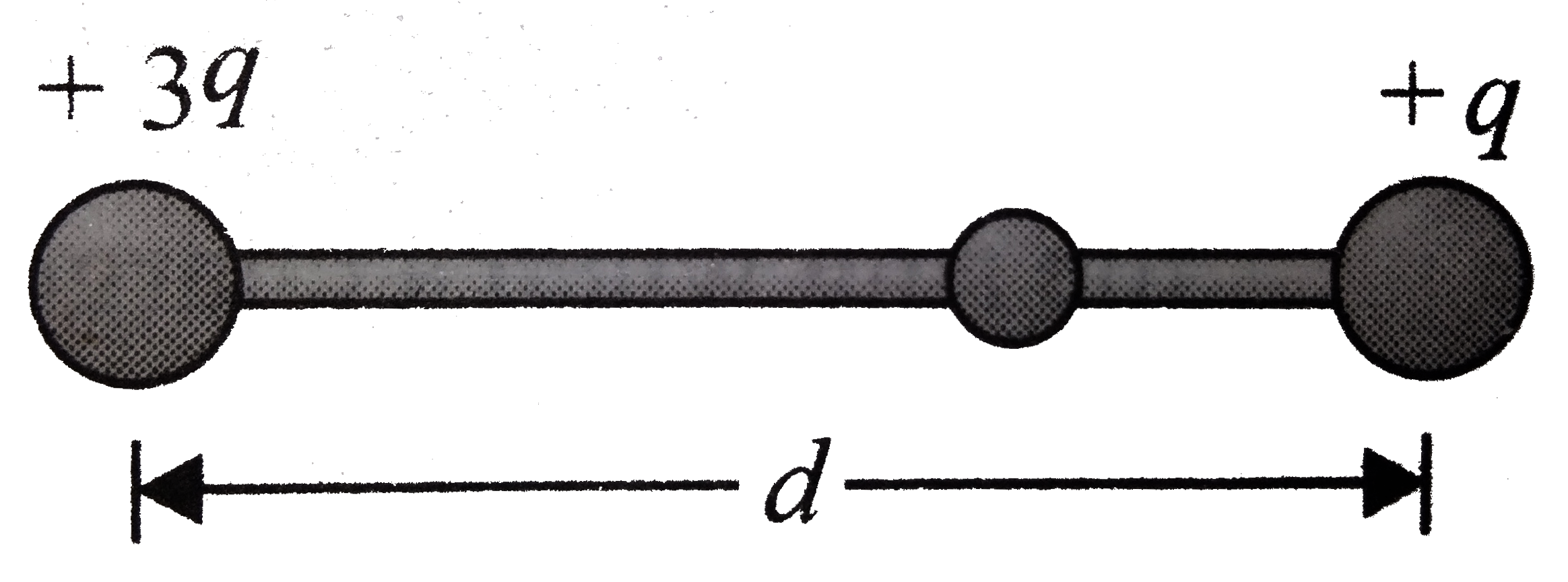 View Solution
View SolutionQuestion 70
A copper atom consists of copper nucles surrounded by 29 electrons. The atomic weight of copper is 63.5gmol−1. Let us now take two pieces of copper each weighing 10g. Let one electron from one piece be transferred to another for every 1000 atom in a piece. ltbRgt (a) Find the magnitude of charge appearing on each piece.
(b) What will be the Coulomb force between the two pieces after the transfer of electrons if they are 10cm apart? View SolutionQuestion 72
A particle of mass 9×10−31 kg having a negative charge of 1.6×10−19C is projected horizontally with a velocity of 106ms−1 into a region between two infinite horizontal parallel plates of metal. The distance between the plates is d=0.3cm and the particle enters 0.1cm below the top plate, THe top and bottom plates are connected, respectively to the positive and negative terminal of a 30V battery. Find the components of hte velocity of hte paricle just before it hits one of the plates.
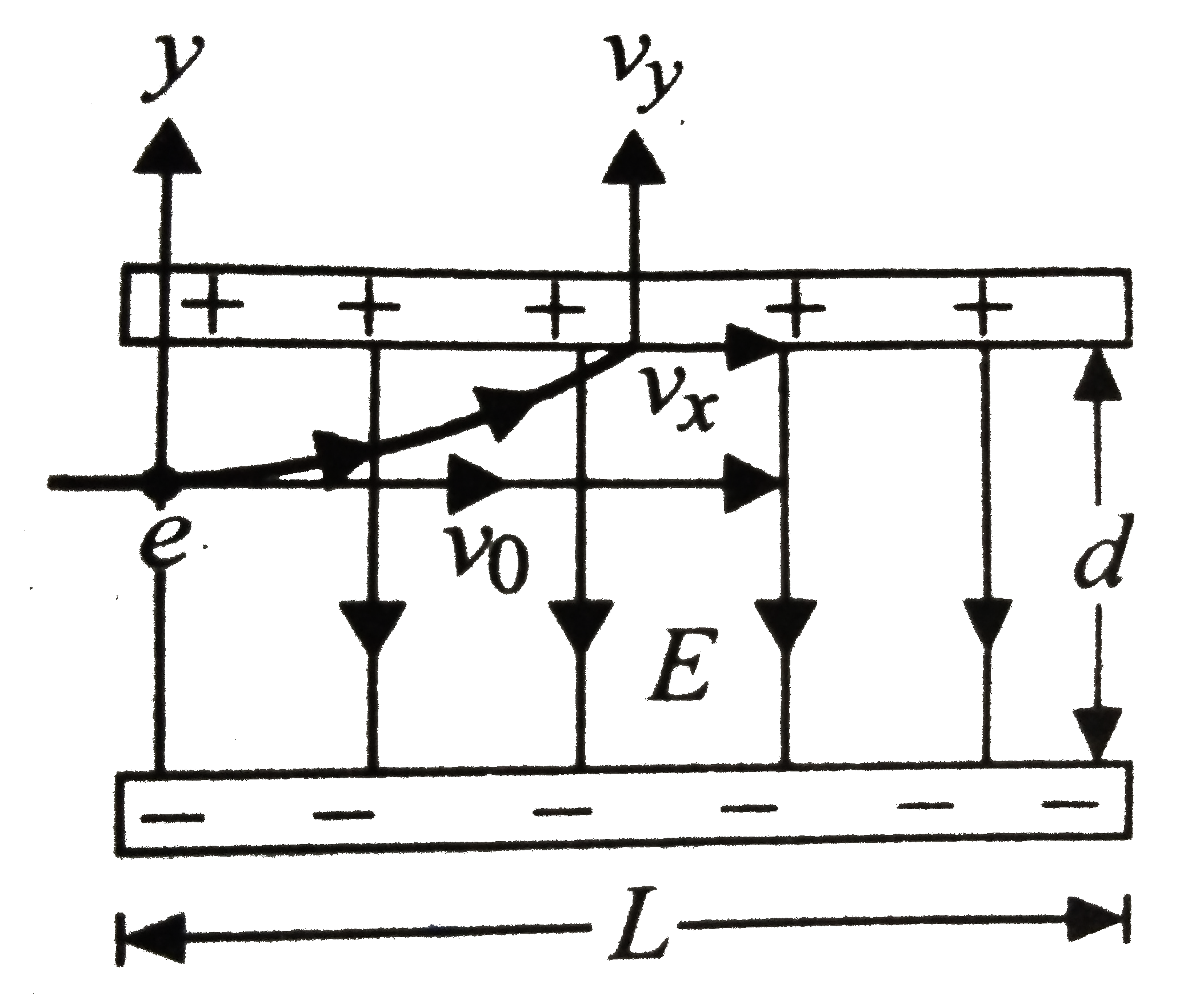 View Solution
View SolutionQuestion 75
A ring of radius 0.1m is made out of thin metallic wire of area of cross section 10−6m2. The ring has a uniform charge of π coulombs. Find the change in the radius of the rig when a charge of 10−8C is placed at the center of the ring. Young's modulus of hte metal is 2×1011Nm−2. View SolutionQuestion 78
Two identical small equally charged conducting balls are suspended from long threads secured at one point. The charges and masses of the balls are such that they are in equilibirum when th distance between them is a(the length of thread L>>a). One of the balls is then discharged, Again for the certain value of distance b(b<<l) between the balls, the equilibrium is restored, the value of (a3/b3)=(□).View SolutionQuestion 79
Two point like charges Q1 and Q2 are positioned at point 1 and 2. The firld intensity to the right of the chaege Q2 on the line that passes through the two charges varies accoreing to a law that is represented schematically in fig. The field intensity is assumed to be positive if its direction coincides with the positive direction on the x-axis. The distance between the charges is l.

The ratio of the absolute values of the charges |Q1/Q2| is View SolutionQuestion 82
Two similar balls, each of mass m and charge q, are hung from a common point by two slik threads, each of length l. Prove that separation between the ball is x=[q2l2πε0mg]1/3, if θ is small
Find the rate dqdt with which the charge should leak off each sphere if the velocity of approach varies as v=a/√x, where a is a constant.
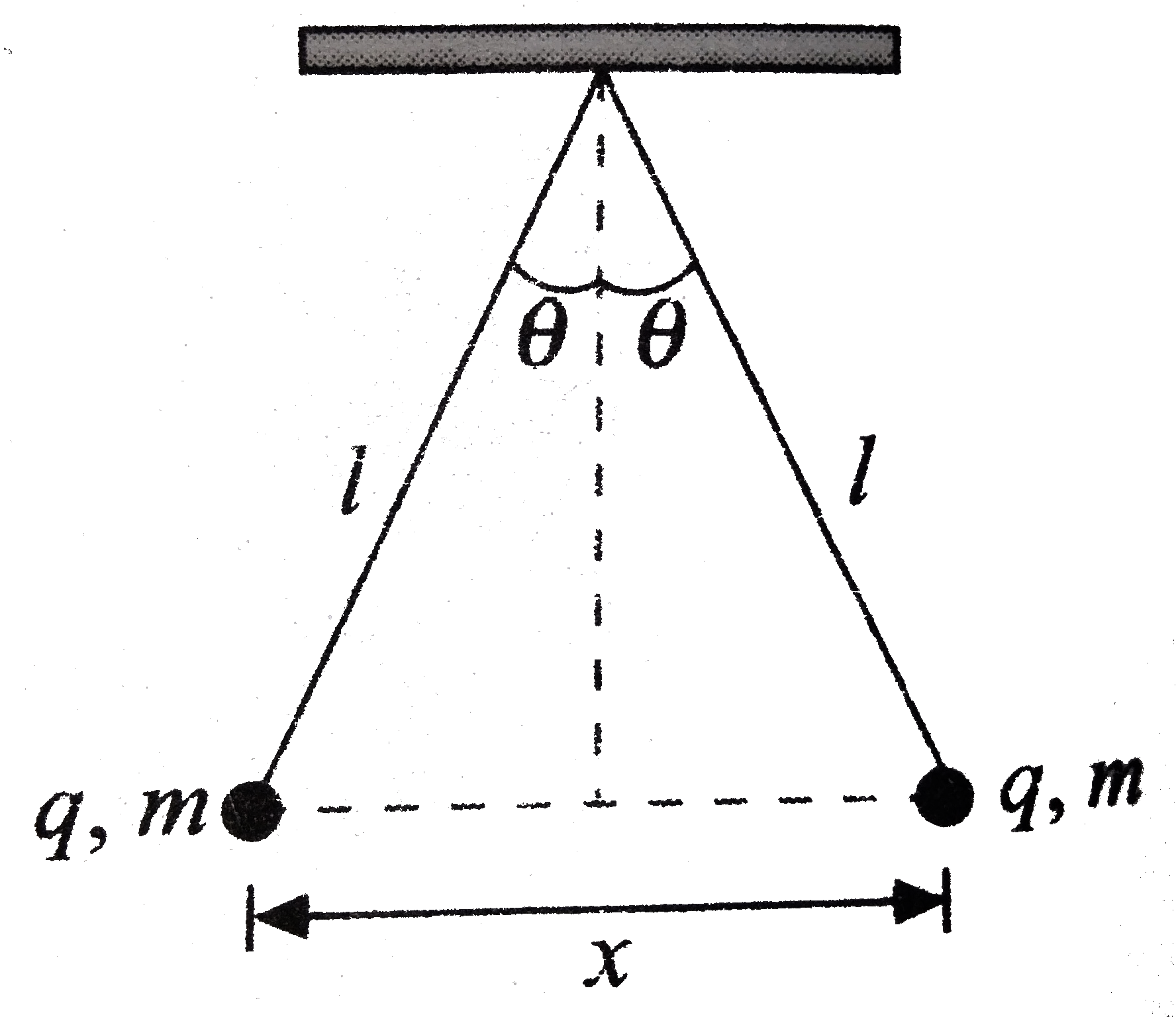 View Solution
View SolutionQuestion 83
Three equal negative charges, −q1 each form the vertices of and equilateral triangle . A particle of mass m and a positive charge q2 is constrained to move along a line perpendicular to the plane of triangle and through its center, which at a distance r from each of the negative charges as shown in fig. The whole systen is kept in gravity-free space, Find the time period of vibration of the particle for small displacement from the equilibrium position.
 View Solution
View SolutionQuestion 84
A ball of radius R carries a positive charges whose volume density at a point is given as ρ=ρ0(1−r/R), Where ρ0 is a constant and r is the distance of the point from the center. Assume the permittivities of the ball and the enviroment to be equal to unity.
(a) Find the magnitude of the electric field strength as a function of the distance r both inside and outside the ball.
(b) Find the maximum intensity Emax and the corresponding distance rm.View SolutionQuestion 85
A uniform nonconducting rod of mass ma and length l, with charge density λ as shown in fig. is hanged at the midpoint at origin so that it can rotate in a horizontal plane without any friction. A uniform electric field E exists parallel to x axis in the entire region. Calculated the period of small oscillation of the rod .
 View Solution
View SolutionQuestion 86
Electrically charged drops of nercury fall from an altitude h into a sperical metal vessel of radius R. There is a small opening in the upperapart of the vessel. The mass of eanc drop is m, and the charge on the drop is Q. What will be the number n of the last drop taht can still enter the sphere?View SolutionQuestion 87
A thin rigid insulated rod of mass m and length l carrying a charge Q unformly distrivuted along its length is smoothly pivoted at P. It is palced in between the charged large conducting plates. Disregard gravity.
(a) Find the initial accelaeration of the rod.
(b) Find the angular speed of the rod as the function of angel θ of rotation ω=f(θ), if the rod is allowed to rotate freely .
 View Solution
View SolutionQuestion 89
A small beads of mass ma having charge -q is constrained to move along a froctionless wire. A positive charges Q lies at a distance L from the wire. Initiallym the bead is just above charge +Q. Show that if the bead is displaced a distance x, where x<<L, and released, it will exhibit simple harmonic motion. obtain an expression for the tive period of simple harnonic motion.
 View Solution
View SolutionQuestion 90
A charged particle q of mass m is in wquilibrium at a height h from a horizontal infinite line charge wit uniform linear charge density λ. The charge lies in the vertical plane containing the line charge. If the particle is displaced slightly (vertically) prove that the motion of the charged particle will be simple harmonic. Also find its time period. View SolutionQuestion 91
A point charge Q1=−125μC is fixed at the center of an insulated disc of mass 1 kg. The disc rests on a rough horizontal plane. Another charge Q2=125μC is fixed verically above the center of the disc at a height h=1m. After the disc is displaced slightly in the horizontall direction (friction is sufficient to prevent slipping), find the period of oscillation of disc.
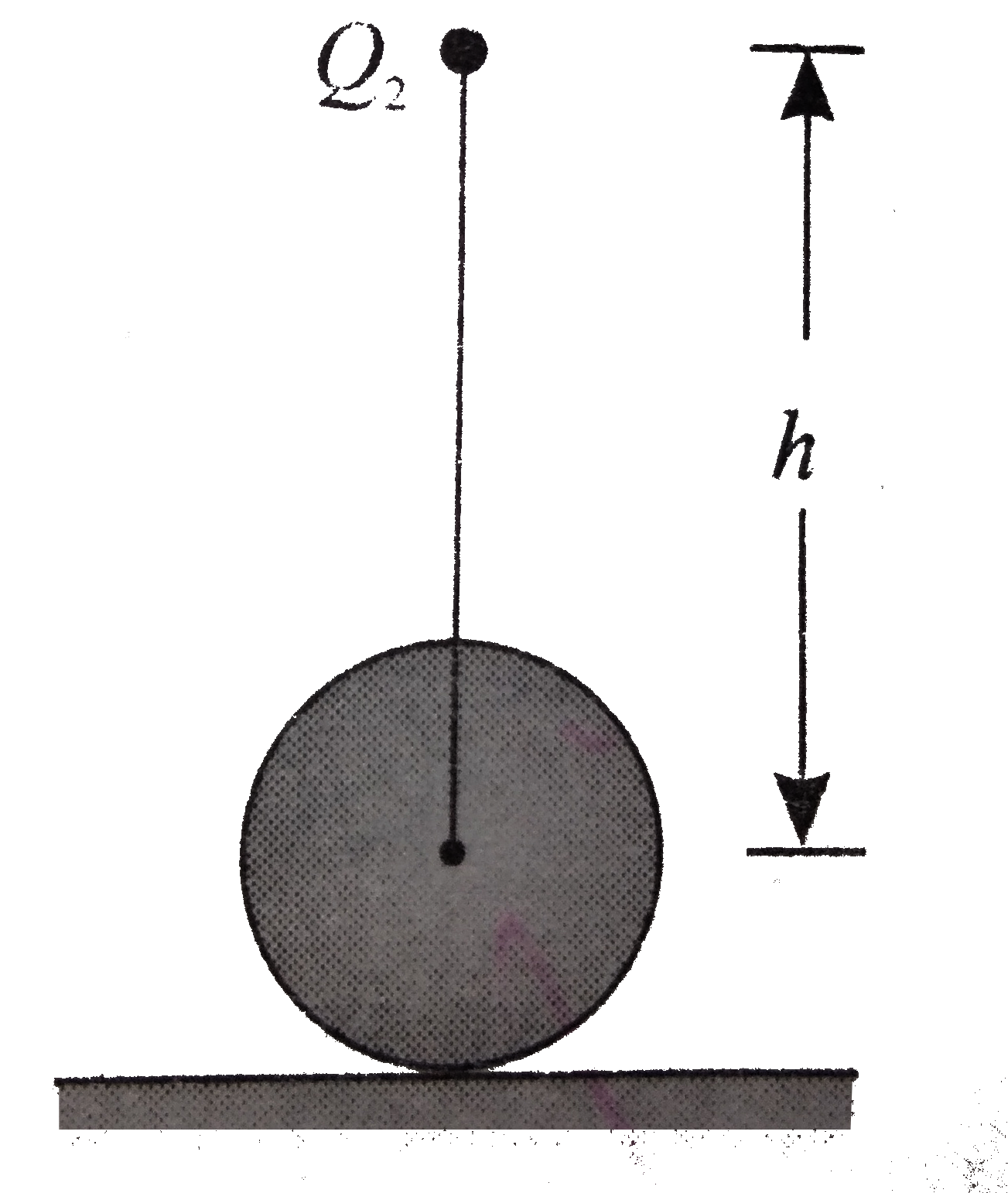 View Solution
View SolutionQuestion 92
Two small balls having the same mass and charge and located on the same vertical at heights h1 and h2 are thrown in the same direction along the horizontal at the same velocity v. The first vall touches the ground at a horizontal distance R from the initial vertical position. At waht heigth h2 will the second ball be at this instant? Neglect any frictional resistance of air and the effect of any induced charge on the ground. View SolutionQuestion 104
An oil drop, carrying six electronic charges and having a mass of 1.6×10−12g, falls with some terminal velocity in a medium. What magnitude of vertical electric field is required to make the drop move upward with the same speed as it was formerly moving down ward with ? Ignore buoyancy. View SolutionQuestion 107
A block of mass m containing a net negative chage −q is placed on a froctionless horizontal tabe and is connected to a wall through an unstreached spring of spring constant k. If the horizontal electric field E parallel to spring is switched on , then the maximum compression of the spring is
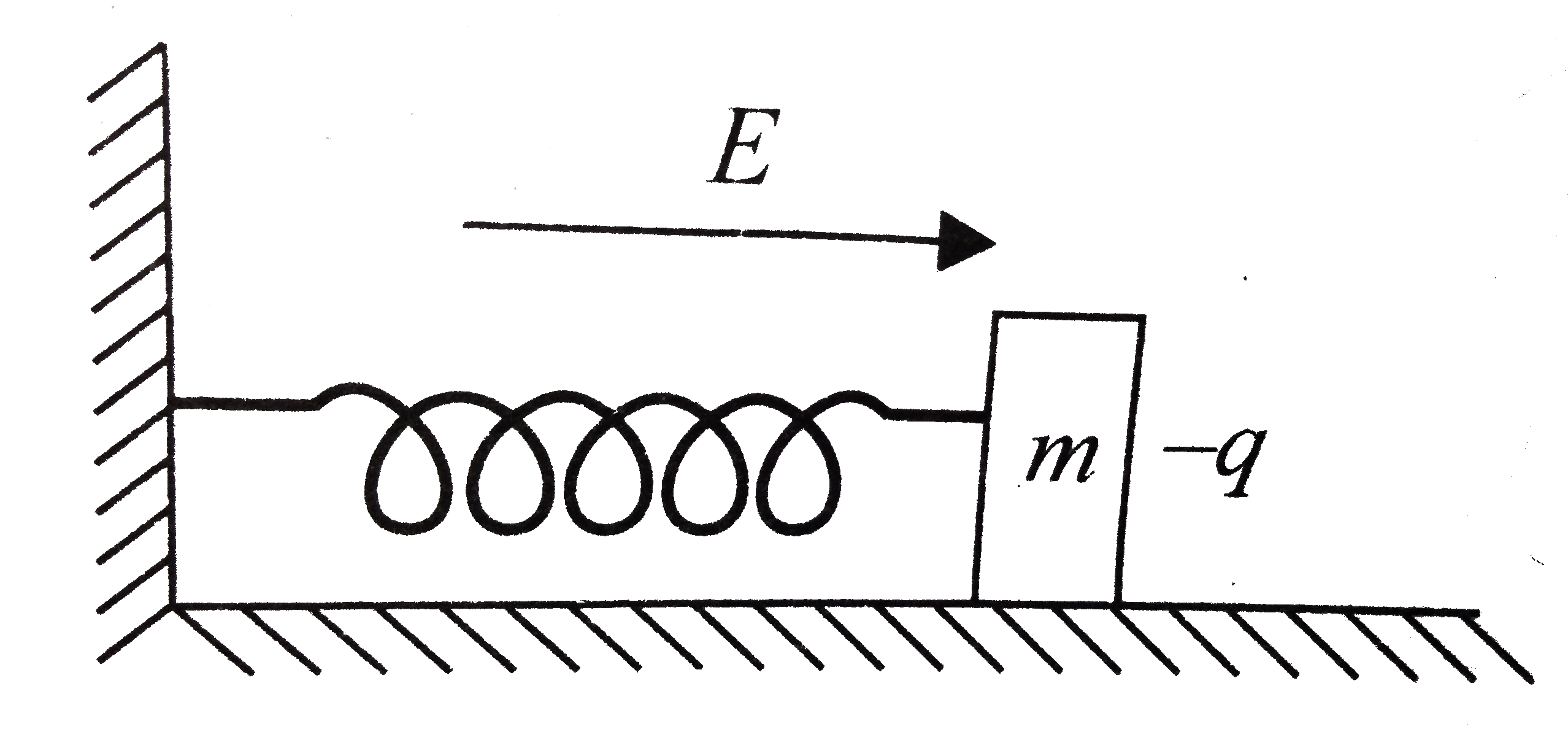 View Solution
View SolutionQuestion 117
A system consits fo a thin charged wire ring of radius R and a very long uniformly charged thread oriented along the axis of the ring, with one of its ends coinciding with the centre of the ring. The total charge of the ring, with one of the ring so equal to q. The charge of the thread (per unit length) is equal to λ. Find the interaction froce between the ring and the thread.View SolutionQuestion 120
A particle of mass m carrying a positive charge q moves simple harmonically along the x-axis under the action of a varying electric field E directed along the x-axis. The motion of the particle is confined between x=0 and x=2l. The angular frequency of the motion is ω. Then which of the following is correct ?View SolutionQuestion 124
two pith balls each with mass m are suspended from insulating threads. When the pith balls are given equal positive charge Q, they hang in equilibirum as shown. We now increase the charge on the left pith ball from Q to 2Q while leaving its mass essentially unchanged. Which of he following diagrams best represent the new equilibrium configuration?
 View Solution
View SolutionQuestion 128
The electric field intensity at the center of a uniformly charged hemispherical shell is E0. Now two portions of the hemisphere are cut from either side, and the remaining portion is shown in fig. If α=β=π/3, then the electric field intesity at the center due to the remaining portion is
 View Solution
View SolutionQuestion 129
A block of mass m is suspended vertically with a spring of spring constant k. The block is made to oscillate in a gravitation field. Its time period is fould to be T. Now the space between the plates is made gravity free, and an electric field E is produced in the downward direction. Now the block is given a charge q. the new time period of oscillation is
 View Solution
View SolutionQuestion 139
A large sheet carries uniform surface charge density σ. A rod of length 2l has a linear charge density λ on one half and −λ on the second half. The rod is hinged at mid-point O and makes an angle θ with the normal to the sheet. The maximum torque experienced by the rod is (if θ is variable) :
 View Solution
View SolutionQuestion 142
In the arrangement shown in fig. The two point charge are in equilibrium. The infinete wire is fixed in the horizontal plane, and the two point charges are placed one above and the other below the wire. Consifering the gravitational effect of the earth, the nature of q1 and q2 can be
 View Solution
View SolutionQuestion 154
Three charges are placed as shown in fig. the magnitude of q1 is 2.00μC, but its sign is unknown. Value of charge q2 is unknown and the value of the charge q3 is +4.00μC, and the net force on q3 is entirely in the negative x-direction

As per the condition given in the problem, the sign of q1 and q2 will be View SolutionQuestion 155
Two point charge Qa and Qb are positional at point A and B. The field strength to the right of charge Qb on the line that passes through the two charges varies according to a law represented schematically in fig. (without employing a definite scale). The field strength is assumed to be positive if its direction coincides with the positive direction of the x-axis. The distance between the charges is l=21cm.

(a) Find the sign of the charges.
(b) Find the ratio between the absolute value of charge Qa and Qb.
(c ) Find the coordinate x of the point where the field strength is maximum. View SolutionQuestion 156
Two point charge Qa and Qb are positional at point A and B. The field strength to the right of charge Qb on the line that passes through the two charges varies according to a law represented schematically in fig. (without employing a definite scale). The field strength is assumed to be positive if its direction coincides with the positive direction of the x-axis. The distance between the charges is l=21cm.

(a) Find the sign of the charges.
(b) Find the ration between the absolute value of charge Qa and Qb.
(c ) Find the coordinate x of the point where the field strength is maximum. View SolutionQuestion 157
Two point charge Qa and Qb are positional at point A and B. The field strength to the right of charge Qb on the line that passes through the two charges varies according to a law represented schematically in fig. (without employing a definite scale). The field strength is assumed to be positive if its direction coincides with the positive direction of the x-axis. The distance between the charges is l=21cm.

(a) Find the sign of the charges.
(b) Find the ratio between the absolute value of charge Qa and Qb.
(c ) Find the coordinate x of the point where the field strength is maximum. View SolutionQuestion 158
Four equal positive charges, each of value Q, are arranged at the four corners of a square of diagonal 2a. A small body of mass m carrying a unit positive charge is placed at height h above the center of the square.
What should be the value of Q in order taht this vody may be in equilibrium? View SolutionQuestion 159
Four equal positive charges, each of value Q, are arranged at the four corners of a square of diagonal 2a. A small body of mass m carrying a unit positive charge is placed at height h above the center of the square.
What should be the value of Q in order that this body may be in equilibrium? View SolutionQuestion 160
An electron is projected with an initial speed v0=1.60×106ms−1 into the uniform field between the parallel plates as shown in fig. Assume that the field between the plates is uniform and directed vertically downward, and that the field outside the plates is zero. the electrons enters the field at a point midway between the plates. Mass of electron is 9.1×10−31kg.
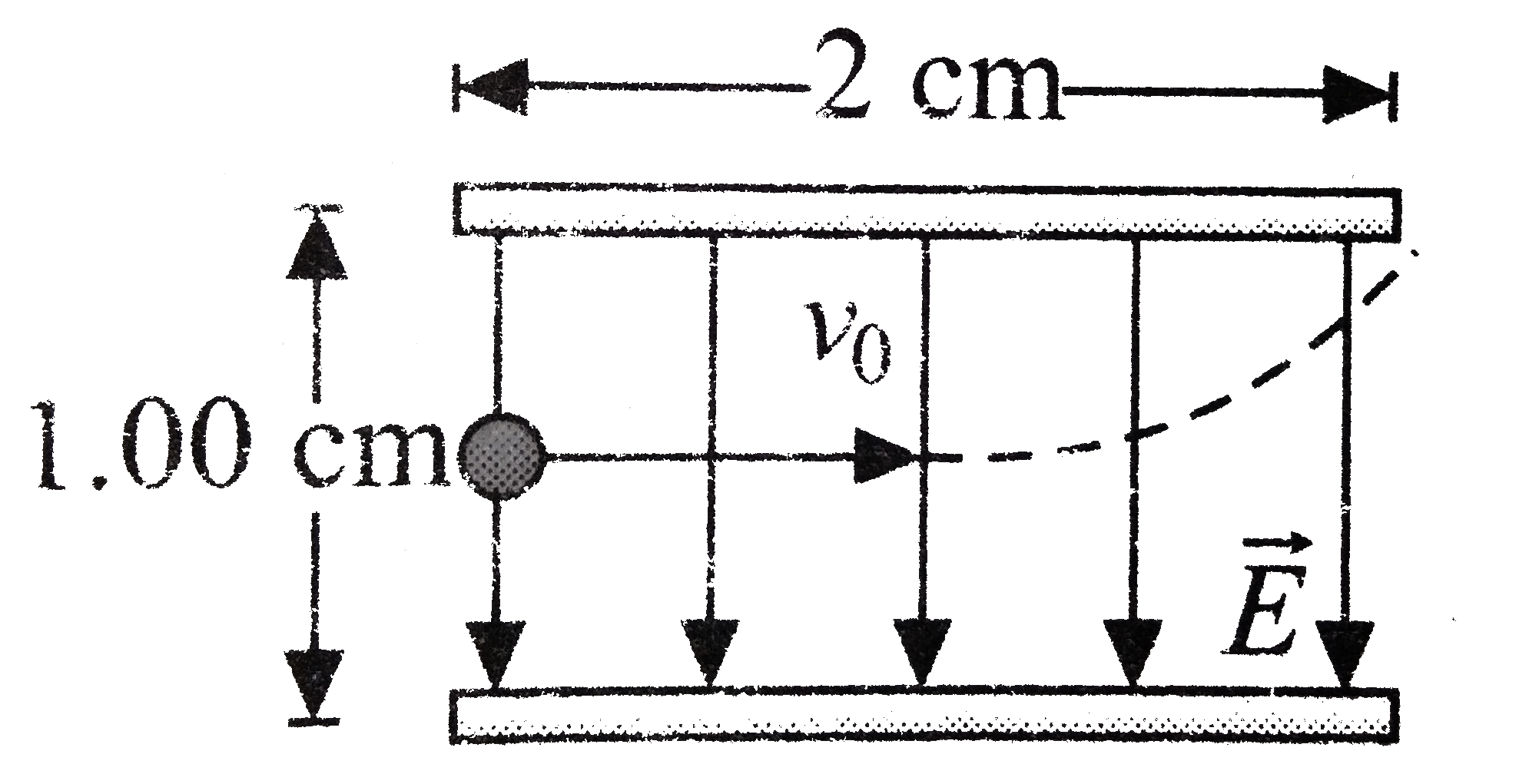
The vertical displacement traveled by the proton as it exits the region between the plated is (mass pf proton is 1.67×10−27kg).View SolutionQuestion 161
An electron is projected with an initial speed v0=1.60×106ms−1 into the uniform field between the parallel plates as shown in fig. Assume that the field between the plates is uniform and directed vertically downward, and that the field outside the plates is zero. the electrons enters the field at a point midway between the plates. Mass of electron is 9.1×10−31kg.

The vertical displacement traveled by the proton as it exits the region between the plated is (mass pf proton is 1.67×10−27kg).View SolutionQuestion 162
An electron is projected with an initial speed v0=1.60×106ms−1 into the uniform field between the parallel plates as shown in fig. Assume that the field between the plates is uniform and directed vertically downward, and that the field outside the plates is zero. the electrons enters the field at a point midway between the plates. Mass of electron is 9.1×10−31kg.

For the condition of hte previous situation, the magnitude of electric field is View SolutionQuestion 163
An electron is projected with an initial speed v0=1.60×106ms−1 into the uniform field between the parallel plates as shown in fig. Assume that the field between the plates is uniform and directed vertically downward, and that the field outside the plates is zero. the electrons enters the field at a point midway between the plates. Mass of electron is 9.1×10−31kg.

If the electron just misses the upper plate, the time of fight of the electron up to this instant is View SolutionQuestion 166
In 1909, Robert Millikan war the firest to find the charge of an electron in his now-famous oil-drop experiment. In that experiment, tiny oil drops were sprayed into a uniform electric field between a horizontal pair of opposite charged plates. The drops were pbserved with a magnitue eyepiece, and the electric field was adjusted so that upward force on some negatively charged oil drops was just sufficient to balance the downward force of gravity. That is, when suspended, upward force qE just equaled mg. Millikan accurately measured the charges on many oil drops and found the values to be whole number multiples of 1.6×10−19C− the charge of the electron. For this, he won the Nobel prize.

If a drop of mass 1.08×10−14kg remains stationary in an electric field of 1.68×105NC−1, then teh charge of this drop is View SolutionQuestion 167
In 1909, Robert Millikan was the first to find the charge of an electron in his now-famous oil-drop experiment. In that experiment, tiny oil drops were sprayed into a uniform electric field between a horizontal pair of opposite charged plates. The drops were observed with a minute eyepiece, and the electric field was adjusted so that upward force on some negatively charged oil drops was just sufficient to balance the downward force of gravity. That is, when suspended, upward force qE just equaled mg. Millikan accurately measured the charges on many oil drops and found the values to be whole number multiples of 1.6×10−19C− the charge of the electron. For this, he won the Nobel prize.

If a drop of mass 1.08×10−14kg remains stationary in an electric field of 1.68×105NC−1, then the charge of this drop is View SolutionQuestion 170
There is an insulator rod of length L and of negligible mass with two small balls of mass m and electric charge Q attached to its ends. The rod can rotate in the horizontal plane around a vertical axis crossing it ata distance L/4 from one of its ends.
At first the rod is in unstabele equillbrium in a Horizontal uniform electric field of field strenght E. Then we gently displace it from this position. Determine the maximim velocity attained by the ball taht is closer to the axis in the subsequent motion View SolutionQuestion 171
There is an insulator rod of length L and of negligible mass with two small balls of mass m and electric charge Q attached to its ends. The rod can rotate in the horizontal plane around a vertical axis crossing it at a distance L/4 from one of its ends.
What is the time period of the SHM as mentioned in the above question, if an electric field E is applied along horizontal? View SolutionQuestion 172
There is an insulator rod of length L and of negligible mass with two small balls of mass m and electric charge Q attached to its ends. The rod can rotate in the horizontal plane around a vertical axis crossing it ata distance L/4 from one of its ends.
What is the time period of the SHM as mentioned in the above question? View SolutionQuestion 174
A rod AB of length L and mass m is uniformly charged with a charge Q, and it is suspended from end A as shown in fig. The rod can freely rotate about A in the plane of the figure. An electric field E is suddenly switched on in the horizontal direction due to which the rod gets turned by a maximum angle of 90∘. The magnitude of E is equal of nMg/Q. Find the value of n.
 View Solution
View SolutionQuestion 178
Four charge particles each having charge Q=1 C are fixed at the corners of the base(A,B,C, and D) of a square pyramid with slant length a(AP=BP=PC=a=√2m), a charge -Q is fixed at point P. A dipole with dipole moment p=1 C-m is placed at the center of the bases and perpendicular to its plane as shown in fig. Force on the dipole due to the charge particles is □4πε0N.
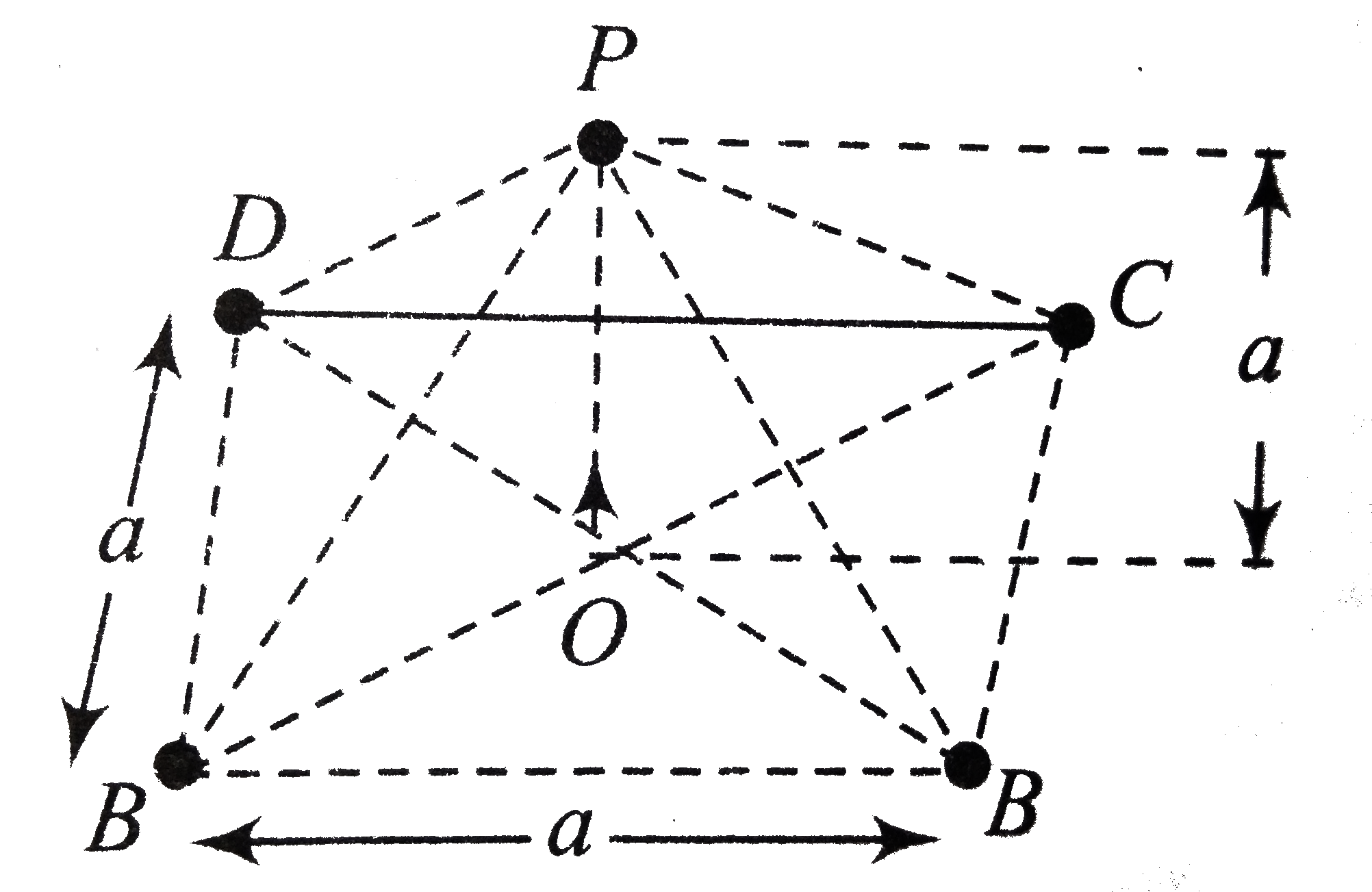 View Solution
View SolutionQuestion 180
Two identical small equally charged conducting balls are suspended from long threads secured at one point. The charges and masses of the balls are such that they are in equilibrium when the distance between them is a(the length of thread L>>a). Then one of the balls is discharged. what will be the distance b(b<<L) between the balls when equilibrium is restored? View Solution



 .
.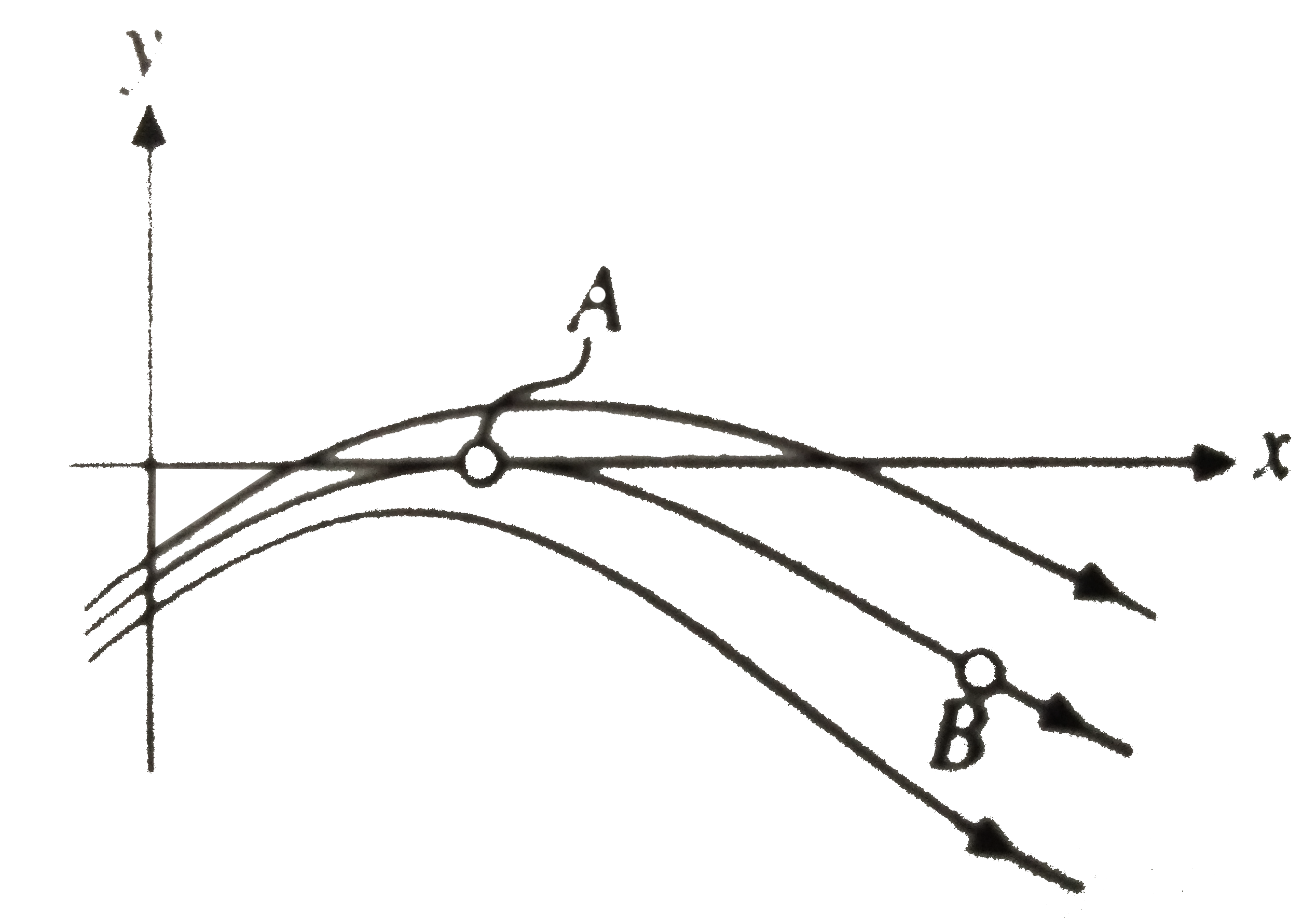 .
.
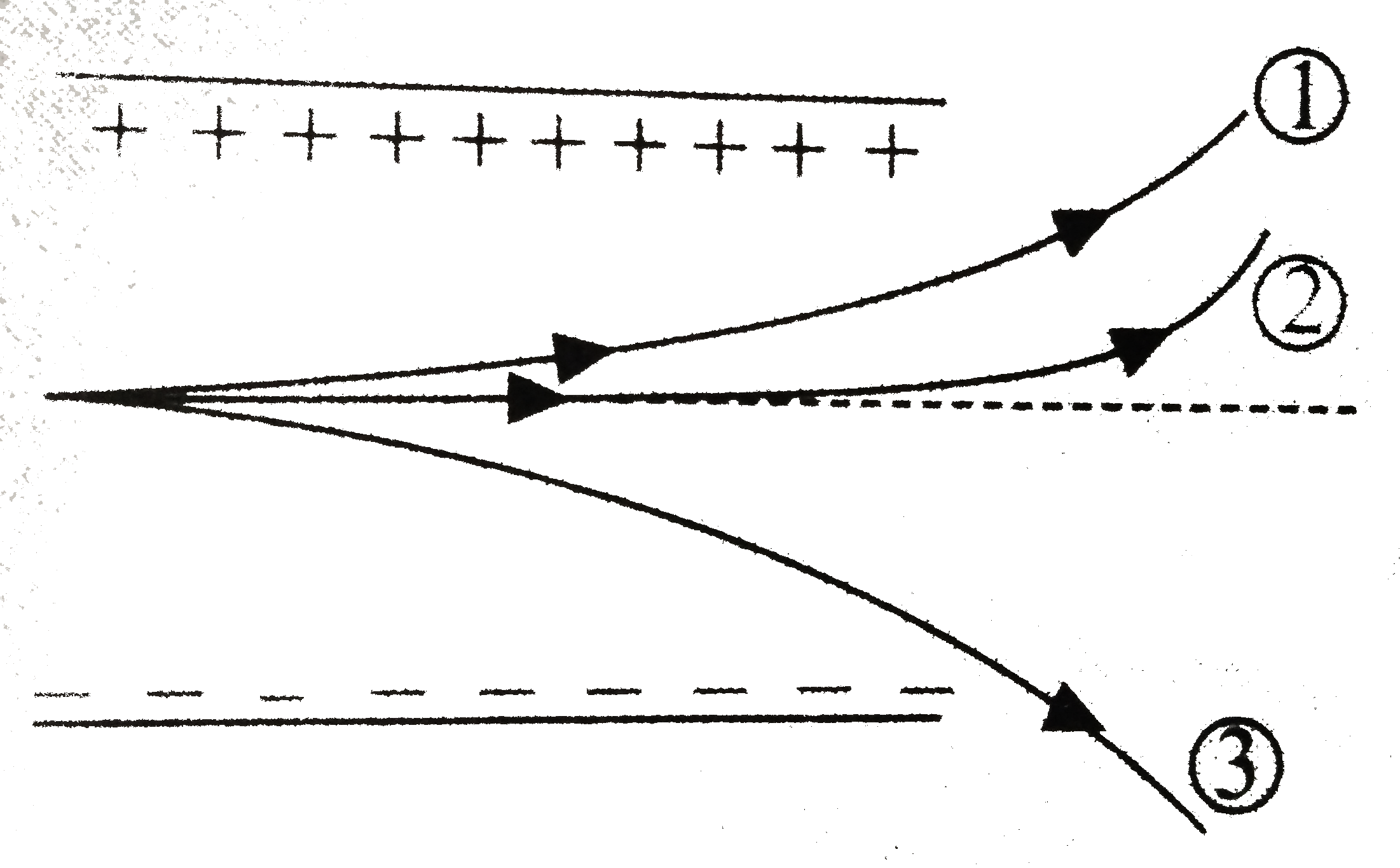



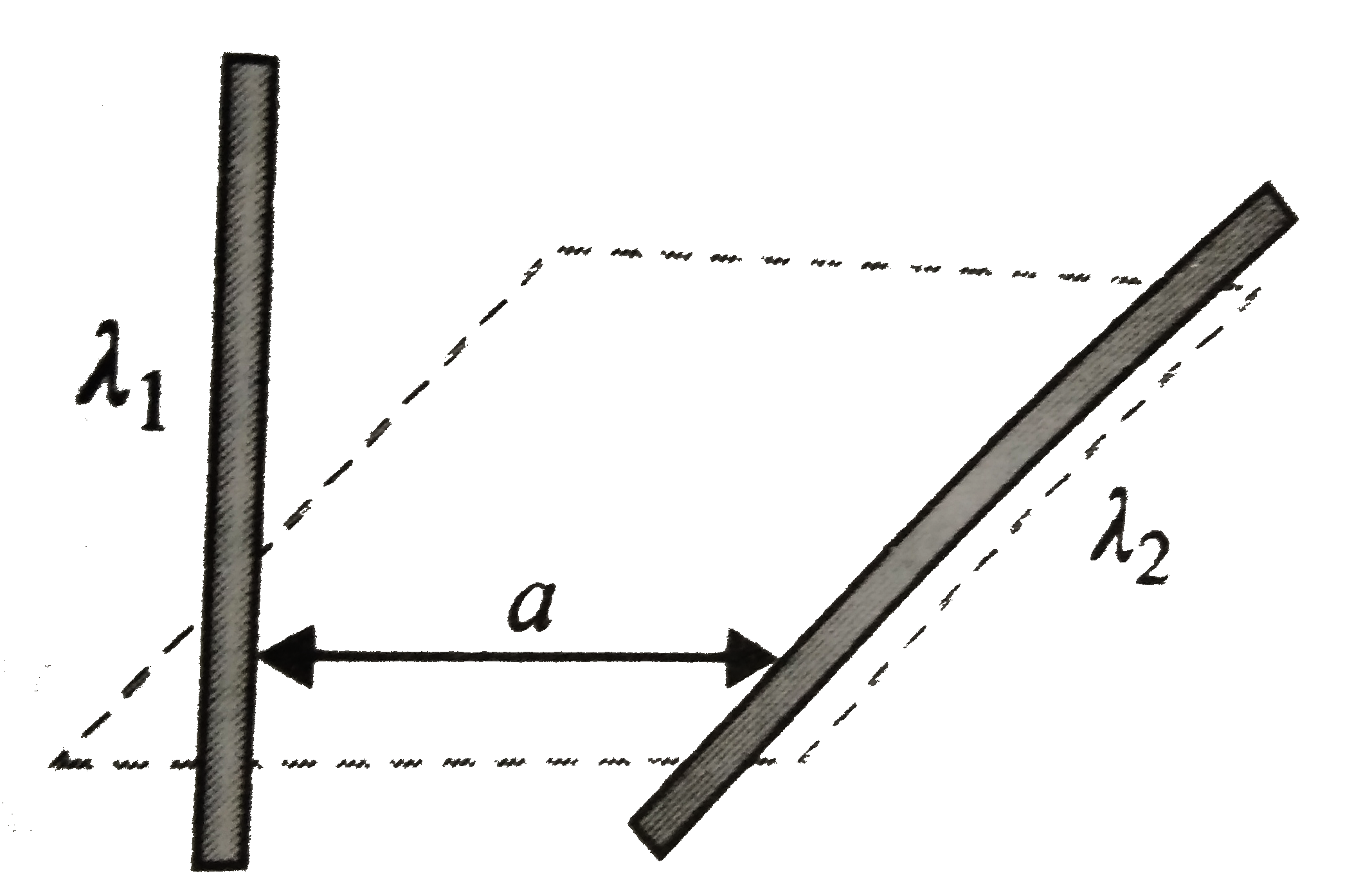












 ,
, 

